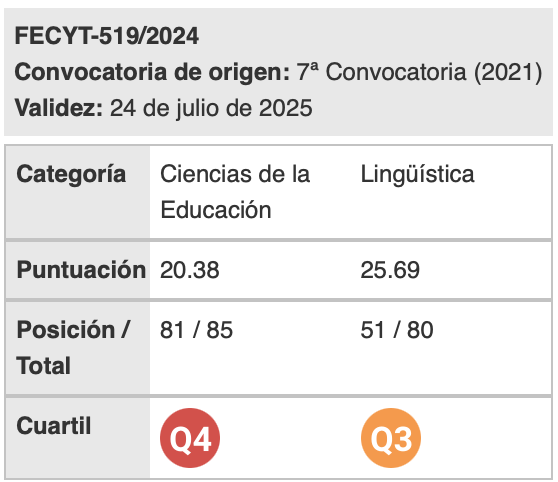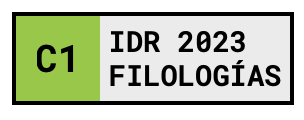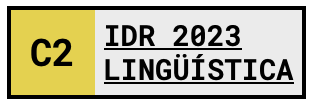Multilingual drafting and standardisation in UE style guides: Analysis of a corpus of prescriptive resources in Spanish, English and French
Keywords:
synoptic approach, drafting, translation, style guides, legal instruments, standardisationAbstract
This article examines the quality of legal drafting in the EU and how it is regulated in the various language versions. To this end, a multilingual corpus of prescriptive texts in Spanish, English and French has been compiled, both for drafting any type of document and for drafting legislative instruments. Notable among the results is that most of these guidelines, which are non-binding except in the case of the Interinstitutional style guide, are general and not very exhaustive and, for the most part, more oriented towards standardising the form than the content. This results in a modification of the expression of the official languages in which these instruments are drafted, in terms of both their structure and of the use of fixed expressions. At the same time, there is an intentional ambiguity, which is used to avoid differences in interpretations depending on the language version.
Downloads
References
Allio, L. (2013). Understanding in order to learn: Comparing features and performance of three legal drafting systems in the EU. Allio Rodrigo Consulting.
Agnoloni, T. et al. (2009). A two-level knowledge approach to support multilingual legislative drafting. In Proceedings of the 2009 conference. En Joost, B. et al (Eds.), Law, Ontologies and the Semantic Web: Channelling the Legal Information Flood, (pp. 177–198). IOS Press, NLD.
Biel, Ł. (2017). Quality in institutional EU translation: Parameters, policiesand practices. En T. Svoboda, L. Biel & K. Łoboda (Eds.), Quality aspects in institutional translation, (pp. 31-57). Berlín: Language Science Press.
Biel, Ł. y Koźbiał, D. (2020). How do translators handle (near-) synonymous legal terms? A mixed-genre parallel corpus study into the variation of EU English-Polish competition law terminology. Estudios de Traducción 10, 69-90. DOI:10.5209/estr.68054
Čavoški, A. (2017). Interaction of law and language in the EU: Challenges of translating in multilingual environment. The Journal of Specialised Translation, 27, 58-74. https://jostrans.org/issue27/art_cavoski.pdf [22/11/2021]
CDT. (2020a). Écrire pour Être Traduit. Luxemburgo: Centro de Traducción de los Órganos de la UE.
CDT. (2020b). Writing for translation. Luxemburgo: Centro de Traducción de los Órganos de la UE.
CE. (1995a). Better Law-Making. Commission Report to the European Council on the application of the Subsidiarity.and proportionality principles on simplification and on consolidation, CSE(95)580. DOUE, 2 de junio.
CE. (1995b). Informe del grupo de expertos independientes sobre la simplificación legislativa y administrativa, COM(95)288 final, 21 de junio.
CE. (1996). Communication from the Commission to the Council and the European Parliament. The Slim Initiative, COM(96) 559 final, 6 de noviembre.
CE. (1997). Declaración sobre la calidad de la redacción de la legislación comunitaria (97 /C 340 /01). DOUE, 10 de noviembre.
CE. (1998). Legislar menos para actuar mejor: los hechos. COM(1998) 345 final, 27 de mayo.
CE. (1999). Acuerdo interinstitucional de 22 de diciembre de 1998 Relativo a las directrices comunes sobre la calidad de la redacción de la legislación comunitaria,1999/C73/01. DOUE, 17 de marzo.
CE. (2001a). Comunicación de la Comisión simplificar y mejorar el marco regulador, COM(2001) 726 final, 5 de diciembre.
CE. (2001b). Informe provisional de la comisión al consejo europeo de Estocolmo, mejorar y simplificar el marco regulador, COM (2001) 130 final, 7 de marzo.
CE. (2001c). La gobernanza europea — un Libro Blanco, 2001/C 287/01. DOUE, 12 de octubre.
CE. (2002a). Comunicación de la Comisión sobre la evaluación del impacto, COM (2002) 276 final, 5 de junio.
CE. (2002b). Documento de consulta: Hacia una cultura reforzada de consulta y diálogo - Propuesta de principios generales y normas mínimas para la consulta de la Comisión a las partes interesadas, COM(2002) 277 final, 5 de junio.
CE. (2002c). La gobernanza europea: legislar mejor, COM(2002) 275 final, 5 de junio.
CE. (2005). Comunicación al Consejo Europeo de primavera trabajando juntos por el crecimiento y el empleo. Relanzamiento de la estrategia de Lisboa, COM(2005) 24 final, 2 de febrero.
CE. (2010). Comunicación de la Comisión al Parlamento Europeo, al Consejo, al Comité Económico y Social Europeo y al Comité de las Regiones. Normativa inteligente en la Unión Europea, COM(2010) 543 final, 5 de octubre.
CE. (2013). Quantifying Quality Costs and the Cost of Poor Quality in Translation. Luxemburgo: Oficina de Publicaciones de la UE.
CE. (2015a). Claire’s clear writing tips.
CE. (2015b). Rédiger clairement: les conseils de Claire.
CE. (2021). English Style Guide. A handbook for authors and translators in the European Commission.
CE. (2016a). Cómo escribir con claridad. Luxemburgo: Oficina de Publicaciones de la UE.
CE. (2016b). How to write clearly. Luxemburgo: Oficina de Publicaciones de la UE.
CE. (2016c). Rédiger clairement. Luxemburgo: Oficina de Publicaciones de la UE.
Consejo de la Unión Europea. (1992a). Conclusiones de la Presidencia – Birmingham, SN 343/2/92. 16 de octubre
Consejo de la Unión Europea. (1992b). Conclusiones de la Presidencia – Edimburgo, SN 456/92. 12 de diciembre.
Consejo de la Unión Europea. (1993). Resolución del Consejo, de 8 de junio de 1993, relativa a la calidad de la redacción de la legislación comunitaria, C 166. DOUE, 17 de junio.
Consejo de la Unión Europea. (2013a). Formulario de los actos establecidos en el marco del Consejo de la Unión Europea. Luxemburgo: Oficina de Publicaciones de la UE.
Consejo de la Unión Europea. (2013b). Formulaire des actes établis dans le cadre du Conseil de l'Union européenne. Luxemburgo: Oficina de Publicaciones de la UE.
Consejo de la Unión Europea. (2013c). Manual of precedents for acts established within the Council of the European Union. Luxemburgo: Oficina de Publicaciones de la UE.
Closa Montero, C. (2003). El Libro Blanco sobre la gobernanza. Revista de estudios políticos, 119, 485-504. <https://recyt.fecyt.es/index.php/RevEsPol/article/view/46118> [20/11/2021].
DGT. (2010a). Guía del departamento de lengua española.
DGT. (2010b). Study on lawmaking in the EU multilingual environment. Luxemburgo: Oficina de Publicaciones de la UE.
DGT. (2013). Study on the size of the language industry in the EU. Luxemburgo: Oficina de Publicaciones de la UE.
DGT. (2015). DGT Translation quality guidelines.
Ferreri, S. (2014). Law, Language and Translation in Multilingual Contexts. King's Law Journal, 25(2), 271-286. https://doi.org/10.5235/09615768.25.2.271
Gallas, T. (2001). La rédaction législative multilingue dans l’Union Européenne : bilan et perspectives. LeGes 12, 115-129. <https://leges.weblaw.ch/it/legesissues/2001/3/20013115-129.html> [22/11/2021]
Garrido, R. (1998). Traducción de textos en la UE: Perspectiva desde Bruselas. Livius: revista de estudios de traducción, 12, 43-50. <https://buleria.unileon.es/bitstream/handle/10612/6734/Traducci%c3%b3n%20de%20textos%20de%20la%20UE.%20Perspectiva%20desde%20Bruselas.pdf?sequence=1&isAllowed=y> [12/10/2021]
Gibová, K. (2009). EU Translation as the Language of a Reunited Europe Reconsidered. En M. Ferenčik y J. Horvath (Eds.), Language, Literature and Culture in a Changing Transatlantic World. International Conference Proceedings, (pp. 192-202). Prešov: Prešov University.
Glanert, S. (2008). Speaking Language to Law: The Case of Europe. Legal Studies, 28(2), 161–171. doi:10.1111/j.1748-121X.2008.00084.x
Hernandez, G. I. (2010). On multilingualism and the international legal process. En H. Ruiz, R. Wolfrum y J. Gogolin (Eds.), Select proceedings of the European Society of International Law, (pp. 441-460). Oxford: Hart Publishing.
Graziadei, M. (2014). Many Languages for a Single Voice. En B. Pasa y L. Morra (Eds.), Translating the DCFR and Drafting the CES, (pp. 71-84). Berlín, Boston: sellier european law publishers.
Guggeis, M. y Robinson, W. (2012). “Co-Revision”: Legal-Linguistic Revision in the European Union “Co-Decision” Process”. En C. J. W. Baaij (Ed.), The Role of Legal Translation in Legal Harmonization, (pp. 51–81). Alphen aan den Rijn: Kluwer Law International.
Jacometti, V. (2020). The Challenges of Legal Translation in Multilingual Contexts. Lingue Culture Mediazioni - Languages Cultures Mediation, 7(1), 83-101. doi:https://doi.org/10.7358/lcm-2020-001-jaco.
Martínez, R. y Montero, S. (2010). Calidad y traducción: el caso de la DGT. Punto y Coma, 118, 3-9. https://ec.europa.eu/translation/spanish/magazine/documents/pyc_118_es.pdf [15/10/2021]
Matías, G. (2005). La Estrategia de Lisboa sobre la sociedad del conocimiento: la nueva economía. Información Comercial Española, ICE: Revista de economía, (820), 169-194. http://repositori.uji.es/xmlui/bitstream/handle/10234/85469/Matias_ Clavero_Estrategia_Lisboa_2005.pdf?sequence=1 [10/11/2021]
Koskinen, K. (2000). Institutional Illusions. The Translator, 6(1), 49-65. https://doi.org/10.1080/13556509.2000.10799055
Ordóñez Solís, D. (1998). Cuestiones lingüísticas y normativas del derecho comunitario europeo. Revista de Derecho Comunitario Europeo, año 2(4), 593-618. <https://recyt.fecyt.es/index.php/RDCE/article/view/48516> [14/11/2021]
Otero Fernández, I. (2020). Multilingualism and the meaning of EU law. [Tesis doctoral. European University Institute].
Pacho Aljanati, L. (2017). Promoting multilingual consistency for the quality of EU Law. International Journal for the Semiotics of Law, 30, 67-79. https://doi.org/10.1007/s11196-016-9482-9
Pascua Mateo, F. (2006). La técnica normativa en el sistema jurídico comunitario. Cuadernos de derecho público,. 28, 125-169. https://revistasonline.inap.es/index.php/CDP/article/view/786 [02/11/2021]
Piris, JC. (2005). The legal orders of the European Community and of the Member States: peculiarities and influences in drafting. Amicus Curiae, 58, 21-28. https://doi.org/10.14296/ac.v2005i58.1090
Prieto Ramos, F. (2014). International and supranational law in translation: From multilingual lawmaking to adjudication. The Translator, 20, 313-331. https://doi.org/10.1080/13556509.2014.904080
Rodríguez Ferrández, S. (2006). La evaluación de las normas penales. Madrid: Dykinson
Robertson, C. (2010a). Legislative drafting in English for non-native speakers: some do's and don'ts (with reference to EU legislation). En M. Gotti y C. Williams (Eds.), ESP across cultures. Special issue: Legal English across cultures (pp. 147-163). Bari: Edipuglia
Robertson, C. (2010b). LSP and EU Legal Language. En C. Heine y J. Engberg (Eds.), Reconceptualizing LSP. Online proceedings of the XVII European LSP Symposium 2009. Aarhus : Aarhus School of Business, Aarhus University.
Robertson, C. (2011). Multilingual legislation in the European Union. EU and national legislative-language styles and terminology. Research in language, 9(1), 51-67. DOI 10.2478/v10015-011-0011-3
Robertson, C. (2012). The Problem of Meaning in Multilingual EU Legal Texts. International Journal of Law, Language & Discourse, 2(1), 1-30. https://www.ijlld.com/840/volume-2/2-1-robertson/ [25/11/2021]
Robertson, C. (2015). EU Multilingual Law: Interfaces of Law, Language and Culture. En S. Sarcevic (Ed.), Language and Culture in EU Law. Multidisciplinary Perspectives (pp. 33-52). England: Ashgate.
Robertson, C. (2016). Multilingual Law: A Framework for Analysis and Understanding. New York: Routledge.
Robinson, W. (2010). Manuals for Drafting European Union Legislation. Legisprudence, 4(2), 129-155. DOI: 10.1080/17521467.2010.11424706
Robinson, W. (2014). Drafting EU Legislation in the European Commission: A Collaborative Process. The Theory and Practice of Legislation, 2(3), 249-272. DOI: 10.5235/2050-8840.2.3.249
Rubio Ortega, M. (2016). Aspectos pragmáticos de la traducción jurídica en las instituciones europeas. Estudios de Traducción, 6, 147-162. https://doi.org/10.5209/ESTR.53009
Šarčević, S. (1997). New approach to legal translation. The Hague: Kluwer Law International.
Šarčević, S. (2013). Multilingual lawmaking and legal (un)certainty in the European Union. Int J Law Lang Discourse, 3(1),1–29. <https://www.ijlld.com/744/volume-3/3-1-sarcevic/> [30/11/2021]
Solan, L. (2017). Some risks and rewards of Europe’s Multilingual order. Contemporary readings in law and social justice, 9(2), 388-399. <https://www.proquest.com/openview/ea86078beb316e5072b0aeb62e9fa9db/1?pq-origsite=gscholar&cbl=136105> [21/11/2021]
Stefaniak, K. (2017). Terminology work in the European Commission: Ensuring high-quality translation in a multilingual environment. En T. Svoboda, Ł. Biel & K. Łoboda (Eds.), Quality aspects in institutional translation, (pp. 109-122). Berlín: Language Science Press.
Strandvik, I. (2014). Is there Scope for A More Professional Approach to EU Multilingual Lawmaking?. The Theory and Practice of Legislation, 2(2), 211-228. DOI: 10.5235/2050-8840.2.2.211
Sutherland, P. (1992). The Internal Market after 1992: Meeting the Challenge. Report presented to the Commission by the High Level Group on the functioning of the Internal Market. (commonly called the Sutherland Report), SEC (92) 2044 final. 31 de octubre.
Svoboda, T. (2013). Translation Manuals and Drafting Style Guides at the European Commission. Le Bulletin du CRATIL Centre de recherche de l'ISIT, 5(10), 80-106. <https://www.isit-paris.fr/app/uploads/2019/04/BDC_10.pdf#page=81> [27/11/2021]
Tartaglia, M. (2015). Getting a movement to move: the plain language movement. icade. Revista de la Facultad de Derecho, 94, 177-208. <https://revistas.comillas.edu/index.php/revistaicade/article/view/5433> [23/11/2021]
UE. (1990). Vademécum del editor. Luxemburgo: Oficina de publicaciones de la UE.
UE. (2003). Acuerdo Interinstitucional “Legislar mejor”. DOUE, C 321, 31 de diciembre
UE. (2012). Versión consolidada del Tratado de Funcionamiento de la Unión Europea. DOUE, C 326. 26 de octubre.
UE. (2015a). Guía práctica común del Parlamento Europeo, del Consejo y de la Comisión para la redacción de textos legislativos de la Unión Europea. Luxemburgo: Oficina de Publicaciones de la UE.
UE. (2015b). Guide pratique commun du Parlement européen, du Conseil et de la Commission à l’intention des personnes qui contribuent à la rédaction des textes législatifs de l’Union européenne. Luxemburgo: Oficina de Publicaciones de la UE.
UE. (2015c). Joint Practical Guide of the European Parliament, the Council and the Commission for persons involved in the drafting of European Union legislation. Luxemburgo: Oficina de Publicaciones de la UE.
UE. (2016). Acuerdo interinstitucional entre el Parlamento Europeo, el Consejo de la Unión Europea y la Comisión Europea sobre la mejora de la legislación, DOUE, L 123. 12 de mayo
UE. (2020a). Manual Común para la Presentación y la Redacción de Actos Sujetos al Procedimiento Legislativo Ordinario.
UE. (2020b). Joint Handbook for the Presentation and Drafting of Acts Subject to the Ordinary Legislative Procedure.
UE. (2020c). Manuel commun pour la présentation et la rédaction standard des actes soumis à la procédure législative ordinaire.
UE. (2021a). Code de rédaction institutionnel. Luxemburgo: Oficina de Publicaciones de la UE.
UE. (2021b). Interinstitutional style guide. Luxemburgo: Oficina de Publicaciones de la UE.
UE. (2021c). Libro de estilo interinstitucional. Luxemburgo: Oficina de Publicaciones de la UE.
Valdivieso, M. (2008). Política lingüística, norma lingüística y terminología en el plano supranacional. Tonos digital: Revista de estudios filológicos, 16 ( 4). <https://digitum.um.es/digitum/bitstream/10201/43347/1/POL%c3%8dTICA%20LING%c3%9c%c3 %8dSTICA%2c%20NORMA%20LING%c3%9c%c3%8dSTICA%20Y%20TERMINOLOG%c3%8dA.pdf > [03/12/2021]
Veroz González, M. A. (2014). La traducción en el Parlamento Europeo. Estudio de los textos técnicos y de comunicación administrativa. [Tesis doctoral, Universidad de Córdoba]. http://hdl.handle.net/10396/12220
Vessela, I. (2005). Competencias del traductor de actos jurídicos comunitarios desde una perspectiva funcionalista. En M. E. García, A. González, C. Kunschak y P. Scarampi (Editores), Actas de las IV Jornadas sobre la Formación y Profesión del Traductor e Intérprete: calidad y traducción. Perspectivas profesionales y académicas. Madrid, Universidad Europea de Madrid.
Visconti, J. (2009). A modular approach to legal drafting and translation. En G. Grewendorf y M. Rathert (Editores), Formal linguistics and law, (pp. 401-426). Berlín: De Gruyter Mouton.
Voermans, W. (2009). Concern about the quality of EU legislation: what kind of problem, by what kind of standards. Erasmus L. Rev., 2, 59-95.
Wagner, E., Bech, S. y Martínez, J. (2002). Translating for the European Union Institutions. Manchester: St Jerome.
Wasilewska, K. (2021). Translation guidelines versus practice: A corpus-based study of the impact of the Polish style guide on translations of EU legislation and reports drafted by the European commission. En M. Bourguignon, B. Nouws y H. Van Gerwe (Editores), Translation policies in legal and institutional settings, (pp. 67-86). Bélgica: Leuven University Press.
Xanthaki, H. (2001). The problem of quality in EU legislation: What on earth is really wrong?. Common Market Law Review, 38, 651-676. DOI:10.1023/A:1010673728428
Xanthaki, H. (2013). European Union legislative quality after the Lisbon treaty: The challenges of smart regulation. Statute Law Review, 35(1), 66–80. DOI:10.1093/slr/hmt005
Wim V. (2009). Concern about the quality of EU legislation: what kind of problem, by what kind of standards?. Erasmus Law Review, 1, 59-95. DOI: 10.553/ELR221026712009002001004
Downloads
Published
How to Cite
Issue
Section
License
Authors who publish with this journal agree to the following terms:
- Authors retain copyright and grant the journal right of first publication with the work simultaneously licensed under a Creative Commons Attribution License that allows others to share the work with an acknowledgement of the work's authorship and initial publication in this journal.
- Authors are able to enter into separate, additional contractual arrangements for the non-exclusive distribution of the journal's published version of the work (e.g., post it to an institutional repository or publish it in a book), with an acknowledgement of its initial publication in this journal.
- Authors are permitted and encouraged to post their work online (e.g., in institutional repositories or on their website) prior to and during the submission process, as it can lead to productive exchanges, as well as earlier and greater citation of published work (See The Effect of Open Access).

Revista de Lenguas para fines específicos is licensed under a Creative Commons Reconocimiento-NoComercial-SinObraDerivada 4.0 Internacional License.

























